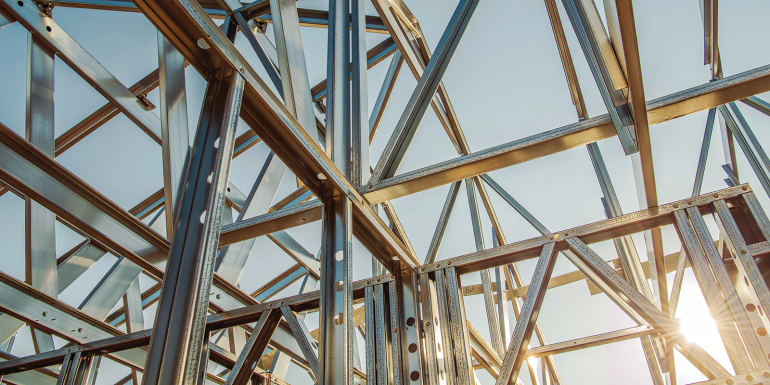Cross Reports - Report 921

Confidential Reporting on Structural Safety. Report 921: Fire protection of mixed hot/cold rolled steel structure
A recent Confidential Reporting on Structural Safety (CROSS) report explores how the use of a hybrid structural system led to inadequate fire protection to some elements and how this was identified and then remediated.
CROSS report 921 describes how a development was designed and constructed with both a traditional steel frame and a lightweight steel framing system (SFS). A mix of the two approaches was used, with commercial units on the lower floors constructed using a steel structure due to the large spans together with acoustic detailing to separate the commercial from the residential above. The upper residential floors were of SFS construction.
This is a high-rise development as defined in the technical standards at the time of application. The period of structural fire protection was revised during the early design process from the required two hours (to meet the prescriptive Technical Standards requirement for long duration of fire resistance) to one-and-a-half hours, achieved through a performance-based fire engineering approach. The agreed method for fire protection of the steel frame structure on the lower storeys was intumescent paint directly applied to the steel. Over this were several layers of plasterboard to form an acoustic separation from the commercial building to the residential buildings above.
The upper residential floors were SFS and were required to meet with tested forms of fire protection and acoustic separation. These were, as is generally the case, determined by the individual SFS supplier.
The SFS was a combination of cold rolled steel C-section studs with flat plate cross bracing brought together as panels that work in combination with hot rolled steel section columns and beams. In areas these resembled steel frames where, for example, the ground floor layouts differ from the upper floor layouts and walls did not stack. The designers’ details were developed on the basis of this information to account for fire separation and the acoustic performance of the structure. The floors were profiled galvanised steel sheets with concrete infill to a minimum 160mm depth. Reinforcement bars were provided as necessary to allow the concrete floor to meet the required and tested fire, structural and acoustic separation. The floors were supported onto a top hat detail or flange of steel beams.
Fire protection of the structural walls was by over-cladding with plasterboard and its specification was determined by the certification provided by the SFS supplier and designer. In all but extreme load cases, the steel posts were sized to be within the depth of the wall panels. Wall structures were fire protected by the plasterboard sheets’ full height. The top hat section and flanges supporting the floors were also fire protected by plasterboard sheeting.
There were some areas where hot rolled steel was required either to support larger floor spans – usually associated with open-plan living areas – or where supporting walls from above did not align with those below. The location and size of these hot rolled steel beams was determined by the SFS supplier. These beams were predominantly encased in the concrete floor and, depending on depth, were occasionally fire protected by the wall cladding. However, they sometimes presented themselves as a base flange or more obvious steel beam depending on depth.
In this case, the understanding of fire protection of these floor steel elements was incomplete and they were not identified as requiring fire protection because they formed part of the floor structure. The specific installation scenarios of these steel beam encasements were not provided on the architectural details and as a result the building was constructed without necessary fire protection encasement in a number of these locations.
Identification & remediation
The issue was identified when a construction-phase inspection by the main contractor of the detailing on another phase of the development queried elements of encasement. Investigation led to an understanding that the encasement was insufficient and the
in-construction phase was remedied. A subsequent intrusive survey of the completed and occupied first phase of the development identified the same issue.
A combination of intrusive survey and revisiting construction information allowed the designers and contractor to understand the extent of the issue and to design a remedial encasement detail that provided the one-and-a-half hour rating for the completed block. To ensure ongoing safety, tenant communication was increased and additional fire alarm and management presence were put in place, while a phased programme of remedial encasement actions was completed.
Considerations
Where a system build product is proposed that is reliant on specific components and detailing being in place, the following should be considered:
- The system supplier and designer should be party to the sign-off process for construction detailing
- The supplier should be requested to provide technical support to the design team and be given the opportunity to review their information
- A greater extent of typical details covering fire and acoustic separation should be provided on the architectural details and verified by the system provider.
Contractually, in circumstances like these there will be no detailing design relationship with the supplier or system designer; but as is clear in this case, their system is reliant on the performance of adjacent components. This indicates that there should be a duty of care on the system supplier and designer to review and ensure that the later production and installation stages of the products used are in accordance with defined specifications.
In this case, the supplier and the system designer are separate entities. Where this relationship exists, the supplier and designer must both have a close working relationship with the design team and contracting organisation from the earliest opportunity.
Comments
Structural fire resistance is an area of significant concern and considerable complexity. Structural engineers are rarely familiar with details of fire engineering concepts and fire engineers are not always familiar with structural response to fire. Involvement of the engineering team, including those who create the fire engineering strategy, should be retained throughout the project, ensuring that the detailed design and construction meet the design intent. Using fire engineering to reduce the period of fire resistance from the standard values (eg in the technical handbooks or Approved Documents) should be done with great care. Too often this is seen as an area to value engineer without properly taking account of issues such as firefighter safety and the importance to society and the environment of preventing a building from collapsing locally or globally.
Occupant evacuation time is just one consideration when determining the degree of fire resistance to be provided by a structure. For higher consequence structures, the durations stipulated in the technical handbooks or Approved Documents should provide opportunity for the fire to burn out or be extinguished by the fire and rescue service, without the building reaching a state of instability.
Reducing the fire protection to the structure could lead to increased risk for firefighters and to others around the building should a collapse occur. It should be recognised that performance-based fire engineering can also be used to increase fire resistance if particular resilience objectives have been identified.
Comprehensive guidance on the matters to be taken into account when considering a performance-based fire engineering approach to structural fire protection is available in the relevant British Standards BS 7974: Fire Safety Engineering and PD 7974-3: Application of fire safety engineering principles to the design of buildings – Structural response to fire and fire spread beyond the enclosure of origin (clauses 5.2 and 5.3) and other sources.
To help others understand the fire strategy, the justification for any alteration in the fire resistance must be developed in association with a wide range of stakeholders, usually via a qualitative design review (QDR), documented and circulated to enable this to be properly understood and considered by the building control body and the relevant fire and rescue service. Safety issues such as those raised in this report stem from potential confusion over both technical and contractual boundaries. The overarching lesson is that the project management process has to recognise the need for collaboration over boundaries including the final demand that one party should oversee the achievement of the safety standards as a whole and thereafter verify that the as-built structure complies.
Fire resistance is part of the structural design; but given that the structural performance of proprietary SMS system rests with the supplier, it may be difficult for the structural engineer to verify performance from first principles. It is hoped that an experienced engineer would recognise this detail as requiring further investigation with the specialist subcontractor. It is further hoped that future regulatory change will require there be a duty holder responsible for ensuring safety throughout projects such as this. Even better would be if the industry recognised the potential benefits and adopted such an approach prior to regulatory instruments being put in place.
Building control bodies have a duty in law to consult with the fire brigade for all building work. The consultation should include information about the design, such as fire engineering.
With thanks to the reporters and the CROSS Expert Panel for sharing their expertise. Taken from the July CROSS reports newsletter, subscribe at [email protected] or visit structural-safety.org for more information










